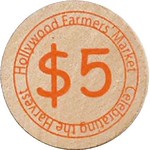
About UsThe Numismatic Bibliomania Society is a non-profit organization devoted to the study and enjoyment of numismatic literature. For more information please see our web site at coinbooks.org SubscriptionsThose wishing to become new E-Sylum subscribers (or wishing to Unsubscribe) can go to the following web page link MembershipThere is a membership application available on the web site Membership Application To join, print the application and return it with your check to the address printed on the application. Membership is only $20 to addresses in the U.S., $25 for First Class mail, and $30 elsewhere. For those without web access, write to: David M. Sundman, Treasurer
AsylumFor Asylum mailing address changes and other membership questions, contact David at this email address: dsundman@LittletonCoin.com SubmissionsTo submit items for publication in The E-Sylum, just Reply to this message, or write to the Editor at this address: whomren@gmail.com BUY THE BOOK BEFORE THE COINSale Calendar |
- WAYNE'S WORDS: THE E-SYLUM MAY 31, 2015
- SKLOW MAIL BID SALE #25 CLOSES JUNE 6, 2015
- NEW BOOK: TERRITORIAL BANKING IN NEBRASKA
- BOOK REVIEW: BENJAMIN FRANKLIN IN TERRA COTTA
- BOOK REVIEW: HISTORY OF U.S COINAGE - GARRETT COLLECTION
- BOOK REVIEW: COINED
- VOCABULARY WORD: OBVERSE
- NOTES FROM E-SYLUM READERS: MAY 31, 2015
- CORNERSTONE COINS MISSING FROM BOSTON PUBLIC LIBRARY
- F.U.N. TO CONTINUE NUMISMATIC AMBASSADOR TRADITION
- FARMER'S MARKET MONEY SUBSTITUTES
- STRIKE CLIP ERRORS
- NEW YORK TIMES COVERS POGUE SALE
- NUMISMATIC AUCTIONS SALE #57 CLOSES JUNE 29, 2015
- QUERY: SHERLOCK SHILLINGS SOUGHT
- QUICK QUIZ: WHO'S IN THIS 1980S ANS VIDEO?
- LEON LEDERMAN 1988 NOBEL PRIZE MEDAL SOLD
- BUYER’S GUIDE TO THE WORLD’S TOP TROPHIES
- 1876 OTTOMAN-ERA WATERMARKED BANKNOTE
- 1831 RUSSIAN PLATINUM 6 RUBLE OVERDATE
- GREEK'S DESIGN CHOSEN FOR EUROPEAN UNION'S FLAG COIN
- MONNAIE DE PARIS FIGHTS COLORIZED FRENCH EURO COINS
- KIDS EXCAVATE OLD COINS FROM A CLASSROOM CLOSET
Click here to access the complete archive
To comment or submit articles, reply to whomren@gmail.com
WAYNE'S WORDS: THE E-SYLUM MAY 31, 2015

New subscribers this week include: Dave Rubin. Welcome aboard! Several obsolete email addresses have been purged from the list this week. We now have 1,841 subscribers.
This week we open with a reminder about David Sklow's upcoming numismatic literature sale, one new book, and three reviews. Other topics include the definition of "Obverse", Farmer's Market money substitutes, strike clip errors, Nobel Prize medal sales, and Russian platinum coinage.
To learn more about Sherlock Shillings, territorial banking in Nebraska, Jean-Baptiste Nini, Brent Pogue's first coin, numismatic Ambassadors, coin shrapnel , read on. Have a great week, everyone!
Wayne Homren
Editor, The E-Sylum
SKLOW MAIL BID SALE #25 CLOSES JUNE 6, 2015
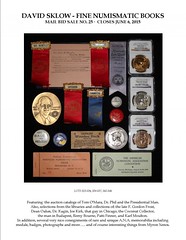
- The Early Auction Catalogs of Tom O'Mara.
- 1947 ANA Buffalo Convention Photograph.
- 1953 ANA Dallas Convention Photograph.
- 1954 ANA Cleveland Convention Photograph.
- Bangs, Merwin & Co. May 29, 1865 J.N.T. Levick Sale interleaved edition.
- Plated Low Sale of the Betts Collection January 11, 1898.
- Plated Sotheby, Wilkinson & Hodges Sale of the W.J. Davis Collection March 11, 1901.
- Raymond/Anderson Galleries Part I, II, & III of The W.W.C. Wilson Sales with beautiful reproduction plates.
- Original Crosby Early Coins of America 1875.
- Friedberg Gold Coins of the World, interleaved deluxe edition.
- Full Leather Newcomb Large Cents 1816-1857 thick paper edition.
- Full Leather Newcomb Large Cents 1815-1857 thin paper edition.
- Deluxe Quarter Leather Bust Half Fever Number 5 of 25.
- DeKnight 1900 second edition History of the Currency.
- Deluxe Hardbound American Numismatic Biographies by Pete Smith Number 13 of 25.
- Early volumes of the Numismatist [unbound] nice!
- Very Rare Early 1910 Official special badges of the ANA Convention.
- Trial Strike of the ANA Medal of Merit.
- The ANA Glenn Smedley Memorial Award.
- The ANA Medal of Merit.
- The Farran Zerbe Memorial Award to Louis S. Werner 1959.
- A three piece ANA 1947 Buffalo Convention medal set, bronze, silver & 10K gold.
- Rare ANA ephemera.
- Many ANA Convention medal sets.
- B. Max Mehl's James Ten Eyck Sale Catalog 1922.
- Deluxe Full Leather Private Gold Coins and Patterns by Don Kagin.
- Early Redbooks.
- Early Bluebooks.
- Many deluxe auction catalogs.
- Montea Imperii Byzaqntini by Wolfgang Hahn four volume set 1973, 1975, 1981, 1989.
- Financing an Empire: History of Banking in California 1927 four volumes by Ira Cross.
- Fabulous set of reproduction photographic plates from the W.W.C. Wilson Sale.
- Illustrium Imagines, 2001 Robert Weiss/George F. Kolbe.
- The United States Mint at Philadelphia 1903 by James Rankin Young.
- Trade Tokens of British & American Booksellers & Bookmakers, by Henry Morris [Bird & Bull Press], 1989.
- First Fine Silver Coinage of the Republic of San Serriffe, by Henry Morris [Bird & Bull Press], 1988.
- Many, many early auction catalogs.
- Many special Redbooks.
- And much, much more!
David Sklow-Fine Numismatic Books
P.O. Box 6321
Colorado Springs, CO 80934
PH: 719-302-5686
FAX: 719-302-4933
Email: numismaticbooks@aol.com
Web Site: FineNumismaticBooks.com
NEW BOOK: TERRITORIAL BANKING IN NEBRASKA
I have finally finished the new edition previously written by Leonard Owen. I obtained the rights to his old book from CSNS (Central States Numismatic Society). I've added some very cool things...
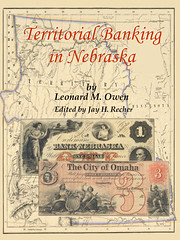
- Over 125 color photos
- Over 300 market prices
- Updated the rarity scale for several banks
- Cross references to McKee, Walton and Haxby
- Historical information on all the cities that circulated paper money
- Many notes that have never appeared in other books (I.E.: proprietary proofs, uncut sheets that appeared in the 1990 Christie's Sale, etc).
- 184 pages, with appendixes
This book should be up on Amazon as an ebook with a day or two. The current price on Amazon for the ebook is $24.99. However, I will be ordering a small print run in paperback.
I want to give the E-Sylum readers a chance to get a pre-order for the paperback plus the ebook for $19.99 (not including shipping). The paperback will retail for $34.99.
In the coming days I will have a website (www.NebraskaPaperMoney.com) up and going where one can pre-order and buy the ebook. The price for the ebook will be $19.99, and the pre-order for the book will be $29.99.
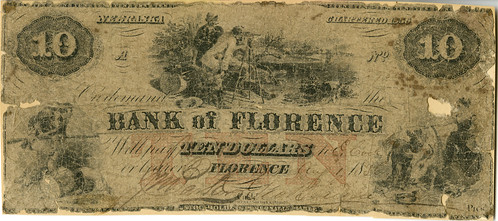
$10 Bank of Florence
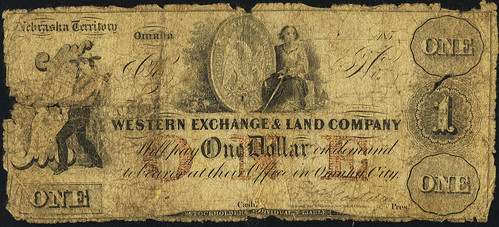
$1 Western Exchange & Land

Jay adds:
The $10 isn't listed in Haxby, and is currently designated as unique. The Bank of Florence is very common as a remainder, but less than 5 examples are known (R7) of the signed notes. All are in full color.
The $1 Western Exchange is courtesy of Heritage Auctions, while the other two notes are from the Bryon Reed Collection.
For those who maybe have questions about the pricing, and which notes have pricing. I got the pricing from auctions, dealers and retail pricing... a mixture. That was my order of preference. Some notes haven't been sold in some time and those notes wouldn't have pricing. I didn't want to make up a dollar figure. The goal of pricing was to give something to the Nebraska and Obsolete collector something they haven't had in a long time - what's it worth.
Each note is broken down to four grades. The four grades are determined by what the collector is going to find most often in the marketplace. Example: a rare note may have: Good - Very Good - Very Fine - Extra Fine... while, a more common note may have: Very Fine - Extra Fine - About Uncirculated - Uncirculated. I did this to give better pricing for each note. On a side note, usually each bank will have the same four grades to give a better continuity.
THE BOOK BAZARRE
BOOK REVIEW: BENJAMIN FRANKLIN IN TERRA COTTA
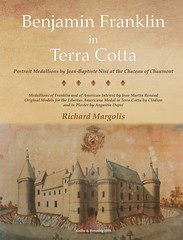 Benjamin Franklin in Terra Cotta, Portrait Medallions by Jean-Baptiste Nini at the Chateau of
Chaumont. By Richard Margolis.
Benjamin Franklin in Terra Cotta, Portrait Medallions by Jean-Baptiste Nini at the Chateau of
Chaumont. By Richard Margolis.
Review by David Thomason Alexander, Fellow ANS, Founder Medal Collectors of America.
Among the most fascinating contemporary collectibles relating to statesman-philosopher Benjamin Franklin are the terra cotta portrait medallions created at Chaumont-sur-Loire, France by the great Italian ceramic artist Jean-Baptiste Nini, born Urbino, Papal States, 1717-1786. Nini worked from from Royal Master of Rivers and forests Jacques Donatien Leray’s Chateau de Chaumont with its pottery and glass works. Leray was Franklin’s friend and provided his lodgings and offices in the picturesque village of Passy outside bustling Paris.
Nini created a myriad of portrait medallions from durable terra cotta (terre cuit) portraying French Kings, noblemen and women, influential clergymen, savants and philosophes, and such foreign notables as Empress Catherine the Great of Russia. To American collectors and savants, his greatest achievement is the group of portrait medallions of B. Franklin Americain in 1777-1779, Ben Franklin as American envoy to France. Books and catalogs including them have appeared since Franklin’s own day, but 2015 has seen the release of what may well be the last word of Nini-Franklin study: Richard Margolis’ Benjamin Franklin in Terra Cotta, Portrait Medallions by Jean-Baptiste Nini at the Chateau of Chaumont. (Kolbe and Fanning, 141 West Johnstown Road, Gahanna, Ohio 43230, 2015. 13¼ x 10 inches. Hard cover, 232 pages, profusely illustrated in color. This book can be ordered from the publisher, at $195.00 per copy.
This massive hardcover work must be described as a signal achievement in book design as well as an exhaustive work in a long-neglected area of U.S. and French numismatics. It is the culmination of decades of research and collecting by author Margolis, long a leading figure in the fields of French and early American numismatics and the history of the medal. Now based in New Jersey, he has been a pioneer in world numismatics in the U.S. since the 1950’s.
He was the founder of the New York International Numismatic Conventions (NYINC) in 1972 and of the Societé pour l’Etude de la Numismatique Française and was originally one of the key players in the International Numismatic Society (INS) in the 1980’s. In the interest of full disclosure, this reviewer wishes to note that he attended NYINC conventions virtually since the beginning, initially as a Coin World writer. He and his bride Pat enjoyed their honeymoon at the December 1977 NYINC, a claim that few can rival!
Along with many other American collectors, the reviewer encountered the terra cotta portrait medallions of B. Franklin Americain early in his collecting career. In his later years as lead cataloguer for such firms as Kagin’s and Stack’s-Coin Galleries, he cataloged several examples, doing as much in-depth research into these classic Franklin portraits as old-established coin firm libraries would permit.
The only generally available reference in the 1980’s was “Medallic Memorials to Franklin” by George and Melvin Fuld, published in The Numismatist, journal of the American Numismatic Association (ANA). Frequently cited in European catalogs was A. Storelli’s Jean-Baptiste Nini. Sa vie – son oeuvre, 1717-1786. (Tours, Imprimerie A. Mame et fils, 1896). This was long regarded as the standard work, listing 107 medallions, among them nine different Franklins. However, it was generally unavailable to American auction catalogers at that time.
Nini was featured in an eight-page listing in Leonard Forrer’s great Biographical Dictionary of Medallists (London, Spink & Son, 1909). Forrer was very thorough with the material at hand but introduced some long-lived inaccuracies, notably his assertions that the Franklin medallions were made with steel moulds and hand- finished after casting by the master himself.
Among later works was Phil W. Greenslet’s The Medals of Franklin. A Catalog of the Medals, Tokens, Medallions and Plaques issued in Honor of Franklin (Token and Medal Society, Lake Mary, Florida, 1993). Greenslet, like the Fulds, presented little more than a list with minimal detail of the kind sought by a competent cataloger.
More recently, Richard Margolis introduced the reviewer and other Americans to the remarkable work of Anna Cerboni Baiardi and Barbara Sibille,1717-1786, Jean-Baptiste Nini, d’Urbino aux rives de la Loire. Paysages et Visages européens, (Federico Motta editore, Milano 2001). Here was a lavishly illustrated 304-page record of an epic Franco-Italian exhibition featuring a cross section of all Nini’s terra cotta portraits “on the banks of the Loire.”
In his detailed examination of Nini’s Franklin terra cottas, Margolis identifies 18 “Petite Module Medallions and Moulds” (measuring up to 127 millimeters) and eight “Grand Module Medallions and Moulds (156 to 165mm) by or after Jean-Baptiste Nini.”
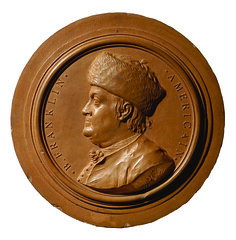 The smaller sizes include busts wearing a Liberty Cap, which give the statesman the appearance
of a country farmer about to retire for the night. A unique mould is shown for a bare head with five-pointed star, followed by busts
wearing spectacles of Franklin’s invention and a run of “Fur cap” types showing the statesman-philosopher wearing his famous Marten fur
hat.
The smaller sizes include busts wearing a Liberty Cap, which give the statesman the appearance
of a country farmer about to retire for the night. A unique mould is shown for a bare head with five-pointed star, followed by busts
wearing spectacles of Franklin’s invention and a run of “Fur cap” types showing the statesman-philosopher wearing his famous Marten fur
hat.
Franklin enchanted the Parisians by his distinctive, democratic style of dress, notably his “old brown coat” and the fur hat that were swept up in the fad for “Franklin fashions” by the novelty-loving populace of the French capital.
Franklin described himself and his hat in a letter of Jan. 12, 1777 to Mary Hewson as “an old Man with grey Hair appearing under a Martin Fur Cap, among the powdered Heads of Paris.” He had brought this headgear back from his journey to Canada in May 1776, and wore it often during his first winter in Paris in place of the conventional wig. The French public identified it with him, and it instantly acquired iconic status.
As writer Claude-Anne Lopez wrote, the circular head piece was “un bonnet de fourrurte, et sentant que cette coiffure liait, dans l’imagination des Français, philosophie et liberté, il reproduisit le bonnet de fourrure de Rousseau.” Identification with revolutionary thinker Jean-Jacques Rousseau reinforced the democratic value of informality in dress.
Margolis then lists three fur hat types with “lunule” spectacles of Franklin’s own invention with no legend, followed by nine types with fur hat and legend B. FRANKLIN AMERICAIN. The latter are the Nini medallions most familiar to American collectors, as they were produced in quantity and readied for shipment to America. Margolis notes several varieties based on lettering, stops, Arms on truncation, dates and impressed fleur de lis on reverse.
Margolis Type 18 (Forrer IV:268-276, Fuld FR.ME.NL-2 Nini). is the variety most likely to be encountered by American collectors today. Examination of the example in the reviewer’s collection with Margolis text in hand reveals that the medallion is uniface Terracotta, 117 to 116.4mm in diameter. The outer rim thickness is 6.8mm at 12:00; 7mm at 6:00.
The obverse presents a high-relief clothed bust l. with long hair escaping from the fur hat. The serif-style French legend is separated by quatrefoil stops, * B. FRANKLIN * - *AMERICAIN *. The letters IN are weak. The truncation bears incuse NINI/ F 1777, with 1777 repeated in field below. Also on the truncation is the fictional Arms, an oval shield displaying an arm flying a kite that attracts lightning, topped by a "fantasy coronet" with palms at sides.
A key feature in variety identification is the tiny relief rosette appearing on the second step of the integral frame at 12:00. The reverse bears a small incuse fleur de lis inset near 10:00. This specimen shows an ancient chip crudely repaired near the tubular hanger extending through the rim and out the back. The back of this example is not flat, and the piece wobbles when set on a flat surface. The patina is a rich saddle-brown.
Many of the medallions surviving today came from a shipment of five or six cases, each containing a hundred medallions, lost in shipwreck near coast of Noirmoutier on their way to United States. Salvaged cases lay forgotten in a Nantes warehouse until 1830, when Customs sold them for a song to the French Navy. A collector, M. Myrvoix, obtained four boxes of medallions, sold two boxes to an official in Angoulême. Others were offered by Spink and Son in England in 1899. All had been carefully packed in a form of stiff paper and were found to be as fresh as the day they were cast.
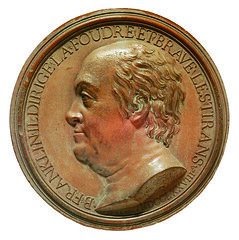 The “Grand Module” Franklin medallions (Margolis 19 through 26) are truly spectacular and rare,
bearing Franklin’s aged head with cropped or flowing hair. Some bear the laudatory French legend B. FRANKLIN DIRIGE A FOUDRE ET BRAVE LES
TIRANS, B. Franklin directed the Lightning and the Scepter of the Tyrant. Dates appear in Roman or Arabic form MDCCLXXVIII, 1778 and
MDCCLXXIX, 1779. Others bear the Latin legend ERIPUIT COELO FULMEN SCEPTRUMQUE TIRANNIS, He Took Lightning from the Heavens and the Scepter
from the Tyrant. Each Type is depicted in full color and detail.
The “Grand Module” Franklin medallions (Margolis 19 through 26) are truly spectacular and rare,
bearing Franklin’s aged head with cropped or flowing hair. Some bear the laudatory French legend B. FRANKLIN DIRIGE A FOUDRE ET BRAVE LES
TIRANS, B. Franklin directed the Lightning and the Scepter of the Tyrant. Dates appear in Roman or Arabic form MDCCLXXVIII, 1778 and
MDCCLXXIX, 1779. Others bear the Latin legend ERIPUIT COELO FULMEN SCEPTRUMQUE TIRANNIS, He Took Lightning from the Heavens and the Scepter
from the Tyrant. Each Type is depicted in full color and detail.
Appendices following the catalog listing include data on important collections holding Nini medallions and an exhaustive examination and partial reconstruction of the methods used by Nini to produce his terra cotta work. Margolis’ careful attention to earlier studies includes a list of corrections to Charles Coleman Sellers’ widely read 1962 Benjamin Franklin in Portraiture.
A particularly valuable aspect of Margolis’ book is his in-depth study of aftercasts or surmoulages, beginning May 1786, when young potter Jacques Mercier leased the pottery works from Leray upon Nini’s death with the specific right to use coins orginaux, original dies. On Aug. 8, 1788, local notary Orien Marais argued against Nini’s heirs receiving payment from later medallion sales, citing excessive profits from sale of aftercasts as originals.
Alfred Viliers was author of Jean-Baptiste Nini, ses terres cuites. (Blois, Imprimerie Lecesne, 1862). Marquis Albert des Méloizes of Bourges wrote about Nini and had terra cotta molds made to show the process, these escaping his control only to reappear as originals in later years!
By far the leading creator and marketer of deceptive Nini copies was Blésois ceramicist Émile Balon, active in the early 1890’s into 1920’s when he was succeeded by Gaston Bruneau. The reviewer encountered one of Balon’s fur hat-spectacles aftercasts while the John J. Ford Hodder collection was being cataloged at Stack’s in 2005.
He needed another specimen for comparison with a recently consigned supposed original from another consignor, unaware that one was actually concealed in-house by the primary Ford cataloger who was typically reluctant to share. In the event, both pieces proved to be Balon copies.
Margolis also offers discussion of rare Franklin terra cotta medallions by Jean Martin Renaud and a lengthy study of terra cotta models for the great Libertas Americana Medal which he attributes to sculptor Claude Michel, known as Clodion. An entire book could easily be written about this medal and the roles played by Clodion and Dupré in its creation. The reader is referred to the 13 pages devoted to it by the ever-thorough Margolis.
No serious collector of Americana and no self-respecting library can be without Richard Margolis’ Benjamin Franklin in Terra Cotta. Both author and publisher have earned the gratitude of the entire numismatic community. Once again, orders should be addressed to Kolbe and Fanning, 141 West Johnstown Road, Gahanna, Ohio 43230.
To read the CoinWeek article, see:
First Read: Benjamin Franklin in Terra Cotta
(www.coinweek.com/education/first-read-benjamin-franklin-in-terra-cotta/)
For more information, or to purchase, see:
BENJAMIN FRANKLIN IN TERRA COTTA. PORTRAIT MEDALLIONS BY JEAN-BAPTISTE NINI AT THE CHATEAU OF CHAUMONT. - See more at:
http://www.numislit.com/pages/books/3473/richard-margolis/benjamin-franklin-in-terra-cotta-portrait-medallions-by-jean-baptiste-nini-at-the-chateau-of#sthash.caBJAKDF.dpuf
(www.numislit.com/pages/books/3473/richard-margolis/benjamin-franklin-in-terra-cotta-portrait-medallions-by-jean-baptiste-nini-at-the-chateau-of)
To read the earlier E-Sylum article, see:
NEW BOOK: BENJAMIN FRANKLIN IN TERRA COTTA
(www.coinbooks.org/esylum_v18n18a03.html)
TOKEN, MEDAL AND POLITICAL AUCTION
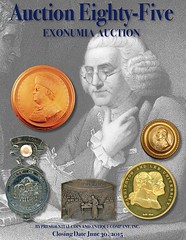
Presidential Coin & Antique Co., Inc.'s Auction Eighty-Five of Tokens, Medals and Political items closes June 30, 2015. Hardcopies $6 - contact Joe Levine at Jlevine968@aol.com or view the catalog online here .
Hard Times Tokens, 19th Century Storecard Tokens, Civil War Tokens, Military & Related, So-Called Dollars, Presidential & Political, World's Fairs & Expositions, U.S. Mint Medals, ANS Medals, Foreign Tokens and Medals, and MORE!
BOOK REVIEW: HISTORY OF U.S COINAGE - GARRETT COLLECTION
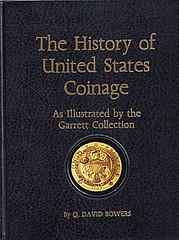 This month, let’s play “Desert Island Numismatic Book,” and choose a single volume we’d
cherish if washed up on Gilligan’s Isle.
This month, let’s play “Desert Island Numismatic Book,” and choose a single volume we’d
cherish if washed up on Gilligan’s Isle.
That’s a tough call for any numismatist. Crosby’s Early Coins of America; Julian’s Medals of the U.S. Mint; Newman and Bressett’s Fantastic 1804 Dollar; Taxay’s U.S. Mint and Coinage? Good choices, all, but my selection would be Q. David Bowers’ masterwork, The History of United States Coinage as Illustrated by the Garrett Collection.
Dave Bowers has written so many wonderful numismatic books, specialized and wide-ranging, popular and scholarly, but to me, The History of U.S. Coinage tops them all. It’s nine books rolled into one: a history of American numismatics; the story of the U.S. Mint; the recounting of how two generations of Baltimore’s Garrett family built a superb coin collection; the saga of colonial and state coinage; the history of Washington pieces; the story of federal coinage; the skinny on territorial/pioneer gold; a “you-are-there” account of the California Gold Rush; and a guide down the byways of numismatic Americana. And then add three appendixes on the behind-the-scenes dealmaking that enabled the Garretts to build their incredible coin collection!
So how did Dave cram all of this into a 572-page book? Double print columns helped, but mainly by a judicious choice of information, focusing on the most important coins of each series, and providing background needed to understand each issue’s context and significance. For example, so many Uncirculated 1773 Virginia halfpence are available because Col. Mendes Cohen of Baltimore owned a keg containing many thousands, which were dispersed slowly from 1875 to 1929, when the last 2,200 of them were sold at auction as a single lot!
The History of U.S. Coinage is a great reference work, but my favorite part is three chapters of appendixes full of correspondence between the Garretts and assorted coin dealers and fellow collectors who helped them build a stellar collection.
There is plenty more in The History of U.S. Coinage to while away the hours until you are rescued from your deserted island. And the good news is that the book is relatively cheap to buy: five printings from 1979 through 1988 have kept it in good supply. Numismatic booksellers usually stock copies, often signed by the author himself.
To read the complete article, see:
Garrett Collection book the desert
island choice if only one selection to read (www.coinworld.com/insights/garrett-collection-book-choice-for-desert-island-read.html)
BOOK REVIEW: COINED
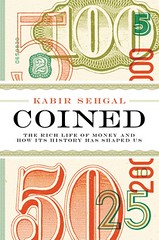 I meant to write earlier about Kabir Sehgal's book; Coined, but I
have been up to my neck in alligators working on my own books.
I meant to write earlier about Kabir Sehgal's book; Coined, but I
have been up to my neck in alligators working on my own books.
Somehow, Kabir found me and sent me an email that he was coming to Viet Nam and other S.E. Asian countries for his work and for his future book. He works in New York City for a large financial institution and specializes in Third World Countries. I told him I was already in Viet Nam and once he had a date he would be in Ho Chi Minh City, tell me and I will clear my calendar for him. That date arrived and I met him in the lobby of the Sofitel Hotel.
We went to a coffee shop and he interviewed me about my numismatic pursuits, and numismatics in general. After about an hour or so, we left and I took him to two of the coin dealers in the city who have shops. He interviewed them and then we went to lunch. He asked for more dealers names in Bangkok and other S.E. and South Asian cities so he could interview them. I gave him the names and email addresses of not only dealers but also some advanced collectors. I also told him he needed to contact Stacks in New York City so he could learn about the U.S. numismatic scene. I have met some of their staff at conventions but I do not know anyone at Stacks. But I do know them to be very reputable and recommended them to Kabir.
He departed Viet Nam and we corresponded via email four or five more times before he had enough of me. People usually get enough of me after only one or two emails! The next time I ran into his name was that his book was published, and then he sent me a complimentary copy.
Instead of speed-reading it, I slowly read it from cover to cover. Most of the book is about the historical background of money and economics. I knew most of it but it was way back in my brain and his book brought many things back into the front. The section on numismatists was great, even with me being in it. I am guessing he asked everyone I recommended to him about me.
Besides everyone in financial institutions, I believe his book should also be read by all serious numismatists, and especially by college freshman before they take their first financial or economics classes. A lot of what is taught/published today has been altered from what actually happened and what was actually written in the past. It is a sad situation in today's "education" classes at every level in most institutions, and those who read his book will be able to better understand the real world of finance and economics.
To read the earlier E-Sylum articles (where Howard is identified by Sehgal as "the Satan of numismatics" for his brutal
honesty), see:
BOOK REVIEW: COINED (www.coinbooks.org/esylum_v18n11a05.html)
BOOK REVIEW: COINED (www.coinbooks.org/esylum_v18n12a07.html)
NUMISMATIC ODDBALLS (www.coinbooks.org/esylum_v18n13a05.html)

VOCABULARY WORD: OBVERSE
Martin Purdy writes:
My rule of thumb when it comes to medals and tokens is that the side identifying the issuing authority is the obverse - so in this case the side with the ANS name. There will always be exceptions but it works in most cases at least. There are problems with this for some people when it comes to New Zealand tokens that show an effigy of Queen Victoria or Prince Albert: since these tokens were not issued under royal authority, the other side (bearing the issuer's name) is usually taken as the obverse, with the royal personage relegated to the reverse, and in most cases they're catalogued this way. It occurs to me that this could make a good quiz question, though one that might lead to a few fights: "When does 'heads' equal 'tails'?"
Dave Lange writes:
I'd like to respond to the question posed in The E-Sylum about how to determine the obverse of a coin or medal.
The rules are a bit different for ancient coins, but in the case of modern world coins, those of the past few hundred years, portraits tend to predominate as obverse devices, with the reverses bearing heraldry and other repeating elements that identify a nation rather than its ruler. The USA followed this same pattern, though the portraits utilized were not those of a ruler until the past hundred years or so.
It gets a little messier with coins that don't feature any kind of portrait. In these instances it seems to me that the overall theme of the coin is the obverse, with the reverse again relegated to heraldry and other statutory inscriptions and devices. Some USA coins pose obvious conflicts with these neat definitions, and an example is the Oregon Trail Memorial Half Dollar. The standing figure of an Indian is not a portrait in the strictest sense, yet traditionally it has been presented as the coin's obverse, and this has almost been made law by the fact that grading companies always place this side up in their holders, unless the submitter requests otherwise. I believe, however, that the wagon/sun side is actually the obverse, as it portrays the commemorative theme of the coin, that is, the Oregon Trail.
Dick Johnson writes:
How to define "obverse"? We all know it is the most important side of a two-sided die-struck numismatic item. "I know it when I see it, but can't put it into words" we might say.
But I did want to put it into words for an entry in my Encyclopedia of Coin and Medal Technology. I had to do considerable research. I learned there are five design factors and two technical factors to determine which side is the obverse.
The design factors are: (1) The side bearing a portrait if the item features a person; in countries with a monarch it is the side with the head or bust of the ruler. (2) In the United States our coinage statues arbitrarily defines the obverse as the side bearing the date, irrespective of any other devices. There are, however, some commemorative coins that break this rule.
(3) For art medals, those not struck in a coining press, the obverse is the side with the highest relief. The medal would rest on the side with the least amount of relief. An extreme case would be a convex-concave medal, the domed side is the obverse.
(4) For military decorations writer John Hetsley Mayer states there is a precise side: "the obverse depicts a chief incident of the war; the allegorical representation is actual equivalent of a verbal inscription and so its properly the reverse of the medal." The obverse is always the side indented be shown when worn.
(5) For nonrepresentational art medals, those without lettering and of a design without perspective or orientation on both sides, the obverse is the side the artist so states. (Like a modern art painting, be sure not to hang it upside down!)
The technical factors: (1) In ancient times the obverse of a coin was always placed in the PILE or anvil position when it was struck. Similar today for multiple-struck medals, the obverse, with the highest relief, is placed in the lower position in the press to reseat if after the medal is struck, removed to be annealed, and returned to be struck another blow.
(2) For medals struck without a collar (with open face dies) they must be trimmed (excess metal squeezes out between the dies around the edge). Large such medals are trimmed on a lathe. Smaller medals, say under 1 1/2-inch, can be trimmed on a drop press with a trimming tool. The medal must be designed with a wide border on one side, this has to be on the reverse. The medal must rest on this border for the trimming tool to shear off the excess metal (the flash). So the obverse is the side without the wide border.
In western countries there exists somewhat of an unwritten law to display the obverse to the left or above the reverse, perhaps because we read from left to right, top to bottom. The obverse is seen first. There is an exception to this rule, however. A left facing portrait side could be shown on the right as if the person portrayed is looking at the reverse.
There was more on the obverse and its relationship to the reverse, but I am saving that for my Encyclopedia.
To read the earlier E-Sylum article, see:
QUERY: WHAT’S AN OBVERSE? (www.coinbooks.org/esylum_v18n21a16.html)
NOTES FROM E-SYLUM READERS: MAY 31, 2015
More on the Hunt for Confederate Gold In Lake Michigan
They're baaaack! The treasure seekers who think the "long lost" Confederate treasury is lying at the bottom of Lake Michigan
claim to have found the wreck of a tug boat they think holds a clue. Thanks to Dick Hanscom for forwarding the story. He found it first in
the Daily Mail, but here's a more detailed USA Today article.
To read the complete article, see:
Shipwreck
discovery may lead to Great Lakes treasure
(www.usatoday.com/story/news/nation/2015/05/28/treasure-hunters-find-shipwreck-in-lake-michigan/28044245/)
To read the earlier E-Sylum article, see:
TREASURE HUNTERS SEEK CONFEDERATE GOLD IN LAKE MICHIGAN
(www.coinbooks.org/esylum_v18n09a35.html)
Numismata Antiqua
Dave Hirt writes:
I want to comment on the Wyatt copies, especially the Good Samaritan Shilling. In the 19th century there was a long debate about the genuineness of this piece. The Chapman brothers cataloged the Bushnell piece as genuine in the sale of his coins in 1882. After questions were raised, they even published a separate supplement attempting to back up their opinion.
I believe the book that the illustrations came from was Numismata Antiqua, a thick volume, almost all of which are ancient coins, that illustrate the coins in the Thomas Pembroke collection published in 1746.
It is an interesting story how I bought this book. At an ANA convention in New York, I was standing with several literature collectors on the bourse floor when a man approached us, and offered this book for sale. I remembered I had once read that this book had the first illustrations of American coins. I started to look through the book.
Phil Carrigan, who was standing next to me said "Dave, you wouldn't be interested in that".
I said. "If what I think is in this book, IS in this book I am interested". Sure enough, I came to a page titled Coins of the English Colonys and Settlements Abroad. Illustrated are the Good Samaritan, Maryland, New England and Carolina coinage. I had the spine rebound in full leather, and now this volume is a prized possession in my library.
To read the earlier E-Sylum article, see:
THE STRUCK COPIES OF THOMAS WYATT AND OTHERS
(www.coinbooks.org/esylum_v18n21a07.html)
Happy Birthday Eric Newman!
I misplaced this greeting last week, so here it is, belatedly. John Feigenbaum writes:
Happy 104th Birthday to the Grand Statesman of American Numismatics.
Eric's son Andy Newman writes:
Thanks for your delightful birthday wishes to Eric. The article stimulated many emails --- with The E-Sylum on top of the pile.
Fred Michaelson writes:
The news about the amazing Eric Newman reminds me of something from a few years back. On his 99th birthday, George Burns said that for his 100th birthday he would rent the London Palladium---if it was still there.
To read the earlier E-Sylum article, see:
HAPPY 104TH BIRTHDAY, ERIC NEWMAN!
(www.coinbooks.org/esylum_v18n21a02.html)

CORNERSTONE COINS MISSING FROM BOSTON PUBLIC LIBRARY
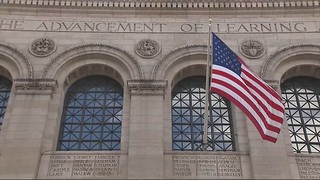 There are more questions about the whereabouts of items thought to be under the safe-keeping of the Boston Public Library.
There are more questions about the whereabouts of items thought to be under the safe-keeping of the Boston Public Library.
A library spokeswoman says a retired employee who now volunteers told administrators last week that gold coins originally placed in the cornerstone of the main building have been missing for decades.
The coins were apparently placed in an 1888 time capsule that was opened in the 1990s. No estimate of the coins' value was disclosed.
A library spokesperson said based on his information, it's believed the coins went missing decades ago.
"The Mayor was made aware on Tuesday during his meeting with Amy Ryan and Jeff Rudman. The Mayor is very disappointed in yet another breach of security," Mayor Marty Walsh spokeswoman Laura Oggeri said in a statement.
Police and the FBI are investigating the disappearance of two pieces of artwork worth more than a half million dollars combined. A top employee has been placed on leave.
To read the complete article, see:
Gold coins missing from Boston
Public Library, volunteer says (www.wcvb.com/news/gold-coins-missing-from-boston-public-library-volunteer-says/33282270)
To read the earlier E-Sylum articles, see:
MASSACHUSETTS STATE HOUSE TIME CAPSULE EXHIBIT
(www.coinbooks.org/esylum_v18n12a09.html)
EXHIBIT: WE ARE ONE (www.coinbooks.org/esylum_v18n18a13.html)
F.U.N. TO CONTINUE NUMISMATIC AMBASSADOR TRADITION
The Numismatic Ambassador Award started in 1974 by Clifford Mishler of Krause Publications. This is an award at grass roots level where numismatists might not otherwise be recognized by the numismatic community. Since its beginnings, over 370 numismatists have received this prestigious award. Every year, nominations are accepted and voted on by the ambassadors. Usually five nominees receive the award at the ANA National Convention Numismatic Ambassador Breakfast. Dave Harper, editor of Numismatic News has been the master of ceremonies.
At the 2014 breakfast, it was announced that this would be the last ambassador awards due to cut backs by the parent company.
After speaking with many ambassadors and numismatic organizations, it was decided that Florida United Numismatists would sponsor the award beginning at the January FUN Show in Tampa Florida. Nothing has changed, both Dave Harper and Cliff Mishler will be running the ceremonies at the breakfast. The integrity of this award will not be compromised.
Tony Swicer is the FUN administrator of the Numismatic Ambassador Award. He is currently updating the numismatic ambassador mailing list and accepting nominations for numismatic ambassadors for January 2016. Contact Tony at;
Tony Swicer
P.O. Box 5823
Lake Worth, FL 33466
swicer@comcast.net
561-964-7236 9AM-11PM
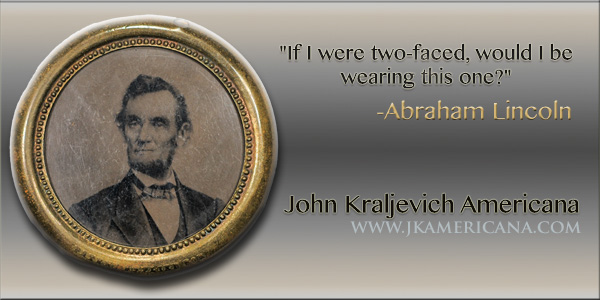
FARMER'S MARKET MONEY SUBSTITUTES
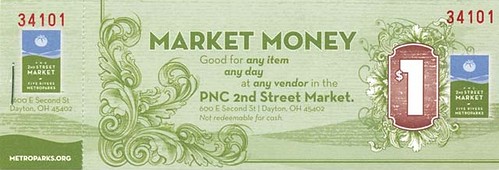
As I write in the article, “Now that many farmers’ markets around the country are opening for another season, the money-minded have a new crop of collectibles to consider. In recent years, the use of wooden nickels, metal tokens, and paper scrip at farmers’ markets has increased, leaving many items for the intrepid collector to track down. And it gives the phrase “paper or plastic” a whole new interpretation.”
The E-Sylum has touched on these items in recent years and my love of farmers markets and the hobby led me to explore this topic. I can’t help but be a little excited to share it with other collectors.
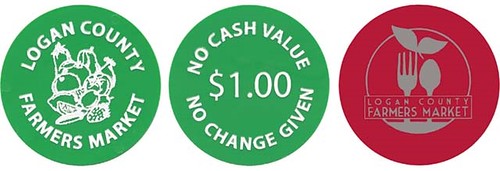
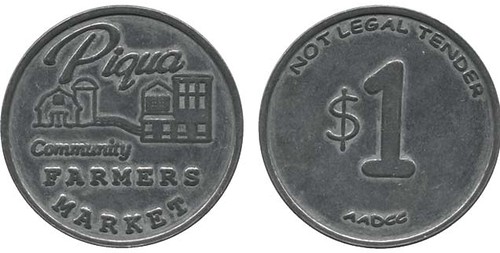
To read the complete article (subscription required), see:
BECOMING A
NUMISMATIC 'LOCAVORE'
STRIKE CLIP ERRORS
etiology
. e·ti·ol·o·gy also ae·ti·ol·o·gy (ē′tē-ŏl′ə-jē)
n. pl. e·ti·ol·o·gies also ae·ti·ol·o·gies
1.
a. The study of causes or origins.
b. The branch of medicine that deals with the causes or origins of disease.
2.
a. Assignment of a cause, an origin, or a reason for something.
b. The cause or origin of a disease or disorder as determined by medical diagnosis.
To read the full definition, see:
etiology (www.thefreedictionary.com/etiology)
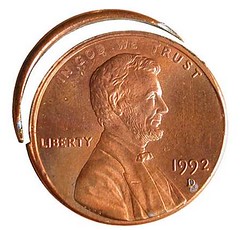

Strike clips arise when a coin or planchet is ripped apart in the striking chamber. Separation may result from vertical shear forces, horizontal shear forces, tensile forces, or combinations of the three. The line of separation may be concave, convex, straight, or uneven.
Previous columns (Aug. 25, 2008; April 5, 2010) considered one type of elliptical strike clip that is created when an off-center planchet is trapped between a descending hammer die and a collar frozen in the “up” position. The planchet’s protruding or exterior portion becomes a concave or crescentic strike clip while the interior portion becomes an elliptical strike clip. Both parts are preserved in the illustrated 1992 Lincoln cent.
A similar event is responsible for the polygonal strike clip on a 1982 Canadian cent. It was apparently sheared in two on the second strike between a stiff collar and a newly-struck cent clinging to the face of the hammer (reverse) die.
While vertical shear forces are responsible for the previous two strike clips, horizontal shear forces are responsible for saddle strike clips. In a saddle (tandem) strike, a planchet is simultaneously struck by two adjacent die pairs. The space between the two off-center strikes tends to buckle upward toward the hammer die.
Strike clips that arise from tensile stresses are close cousins of “coin shrapnel” (Collectors’ Clearinghouse, Dec. 21, 2009). The latter term refers to fragments that break away from multi-struck coins, pile-ups, and disintegrating die caps. Tensile strike clips also share affinities with coins torn apart as the result of being struck through hardware or machine parts. Here we confine the strike clip moniker to those coins sundered in a single strike and where nothing but discs of coin metal were involved.
Collectors should be aware that many kinds of strike clips are erroneously described and encapsulated as “struck fragments,” “struck scrap,” and various types of conventional clips.
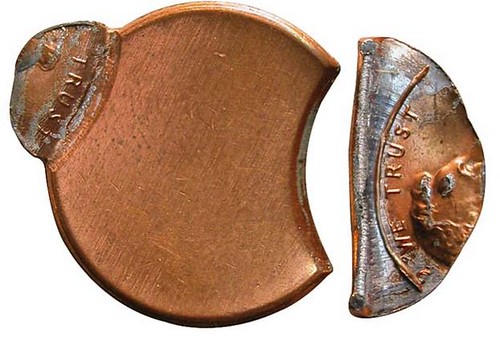
Two strike clips - one straight and one concave
To read the complete article, see:
Strike clips diverse in form, etiology
(www.coinworld.com/insights/strike-clips-diverse-in-form-etiology.html)
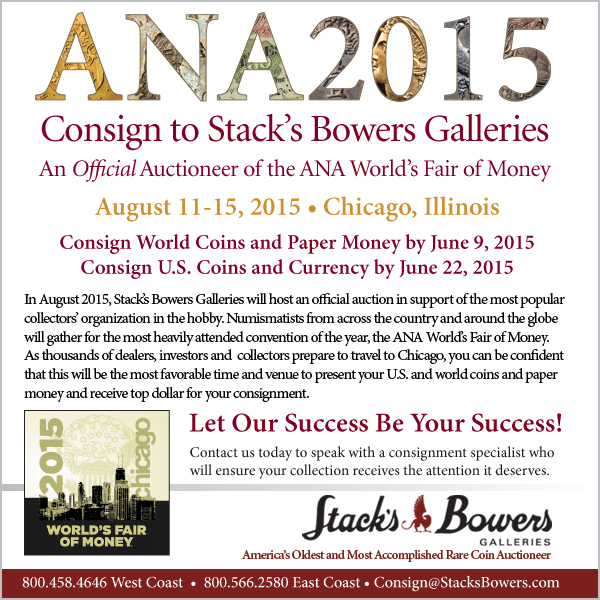
NEW YORK TIMES COVERS POGUE SALE
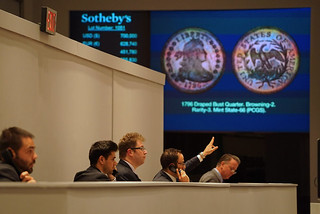 THE
first coin that captured D. Brent Pogue’s attention was a 1915 wheat penny. He was 10 years old, and at the time, he thought it was worth
$250 million.
THE
first coin that captured D. Brent Pogue’s attention was a 1915 wheat penny. He was 10 years old, and at the time, he thought it was worth
$250 million.
“The only value of that coin is my sentimental attachment to it,” Mr. Pogue said from his home in Dallas. He estimated the penny is probably worth 2 cents today.
But he went on to buy far rarer coins, including the only 1822 Half Eagle gold piece in private hands, in a 40-year quest to build the pre-eminent collection of early American coins. “I fell in love with the history of our country, the history of our coins, the artistic beauty of our coins,” he said.
Mr. Pogue, 50, has decided to sell his collection of some 680 coins, which the specialty auction house Stack’s Bowers Galleries estimates could fetch more than $200 million. Not bad for pocket change with a face value of $769.14, according to Brian Kendrella, president of Stack’s Bowers.
Mr. Pogue has a particularly rich collection of coins with a built-in audience of coin enthusiasts. Even so, strategy is the key to getting the most from the sale of a collection. That is why Stack’s Bowers has spaced out the coin sales over seven auctions in the next three years. The first was last week.
A 1797 half dollar. The first auction of Mr. Pogue’s coins brought in $25 million, and six more are planned. Credit Nicole Bengiveno/The New York Times And while it is a heady time in the art and auction world — Christie’s recently set a record by selling more than $1 billion of postwar and contemporary art in one week — such headline-grabbing numbers make selling art seem easy.
In most cases, selling a collection will take years and result in many unsold pieces. To prevent disappointment — or worse, many unsold lots — sellers need to ask tough questions of the auction houses or galleries that want to represent them, and be reasonable about the value of what they have amassed.
The first thing someone wanting to sell a collection needs is a story to hold it together. “Many people can put together groups of things that are called collections,” said Jonathan Rendell, a deputy chairman of Christie’s. “But a really great collection is completely bound together. The objects and the collector are one thing.”
To read the complete article, see:
Selling Private
Collection of Artifacts Requires Special Care
(www.nytimes.com/2015/05/30/your-money/selling-private-collection-of-artifacts-requires-special-care.html)
NUMISMATIC AUCTIONS SALE #57 CLOSES JUNE 29, 2015
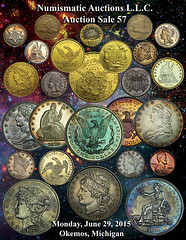 Auction Sale #57 is a really unique sale, it features a very interesting mix that should pique the
curiosity of many collectors and dealers alike. A continuing selection of material is listed from the Andrew Tuttle Memorial Museum in
this, the second offering from that fine collection as well as items from a myriad of other fine consignments. Leading the way in Session
One is a comprehensive group of United States type coins and series issues with highlights in 19th and early 20th Century Proof and better
circulated grade issues as well as key dates, overdates, varieties and the like. Capped Bust and Seated types are well represented in
various denominations and an eclectic run of odd denomination coins is also present. The sale contains Colonial Coinage to Classic United
States Commemoratives, Gold, Proof Sets, Patterns and more - all rounded out by a nice run of Republic of Texas notes and some unusual
exonumia. The vast majority of the material is uncertified and has been off the market for several decades, making it even more exciting in
the bidding arena. Next up and rounding out Session Two following the United States material, is a large collection and accumulation of
Canadian and Maritime coinage, tokens and sets, appointed by some tougher issues and many larger collector grade lots and runs of
dates.
Auction Sale #57 is a really unique sale, it features a very interesting mix that should pique the
curiosity of many collectors and dealers alike. A continuing selection of material is listed from the Andrew Tuttle Memorial Museum in
this, the second offering from that fine collection as well as items from a myriad of other fine consignments. Leading the way in Session
One is a comprehensive group of United States type coins and series issues with highlights in 19th and early 20th Century Proof and better
circulated grade issues as well as key dates, overdates, varieties and the like. Capped Bust and Seated types are well represented in
various denominations and an eclectic run of odd denomination coins is also present. The sale contains Colonial Coinage to Classic United
States Commemoratives, Gold, Proof Sets, Patterns and more - all rounded out by a nice run of Republic of Texas notes and some unusual
exonumia. The vast majority of the material is uncertified and has been off the market for several decades, making it even more exciting in
the bidding arena. Next up and rounding out Session Two following the United States material, is a large collection and accumulation of
Canadian and Maritime coinage, tokens and sets, appointed by some tougher issues and many larger collector grade lots and runs of
dates.
Session Three of Auction Sale #57 takes the bidder to all corners of the globe with an intriguing array of World Coins from Ancient and Gold Coinage to World Crowns and Minors, World Paper Money, Tokens and Medals. There is an enticing display of better grade items, rarer one and two-year type coins, Patterns, Proofs and more. The catalog is augmented by a historic group of cut and countermarked issues and fantasies originally from the Howard Gibbs sales by Hans Schulman as well as some outstanding official Colonial to Provisional issues of Caribbean, Latin and South American nations, as well as a highly diverse mix of other countries from Asia to Europe and beyond, some great seldom seen types and denominations for the collector as well as some literally massive lots of World Coins from around the planet for the dealer or eBay selling enthusiast. The entire 80 page catalog is profusely illustrated with full color images.
There should be an outpouring of participation given the breadth and depth of the sale with affordable items for the collector throughout as well as some higher end rarities. Catalogs are available free of charge by request from Steve Davis at Numismatic Auctions LLC, PO Box 22026, Lansing, MI 48909, Tel: 517-394-4443/ Fax: 517-394-0579, Email: numauctionsllc@aol.com or the entire Sale #57 Auction listing can be viewed online at www.numismaticauctionsllc.com
Steven L. Davis
Numismatic Auctions L.L.C.
P.O. Box 22026
Lansing, MI 48909
USA
www.numismaticauctionsllc.com
Phone: 517-394-4443
Fax: 517-394-0579
Email: numauctionsllc@aol.com
THE BOOK BAZARRE
QUERY: SHERLOCK SHILLINGS SOUGHT
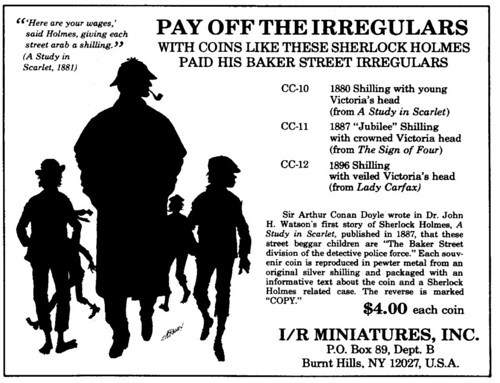
The above advertisement comes from the June 1987 issue of The Baker Street Journal (page 100, to be exact). A New York based company, I/R Miniatures, was selling replicas of the three different designs of the shillings issue during Queen Victoria’s reign.
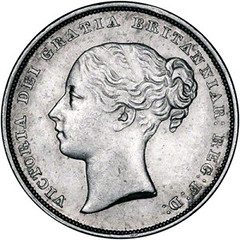 Instead of being struck in silver, like the original coins, these replicas were struck in pewter and sold for $4 each. Each coin was marked
“COPY” on the reverse, as in accordance with the Hobby Protection Act of 1973.
Instead of being struck in silver, like the original coins, these replicas were struck in pewter and sold for $4 each. Each coin was marked
“COPY” on the reverse, as in accordance with the Hobby Protection Act of 1973.
These replica coins seem odd to your editor, as it would only be a few dollars more at the time to purchase the real silver coins.
The ad goes on to state that each replica coin is accompanied by “informative text about the coin and a Sherlock Holmes story.”
So, does anyone out there seen these replicas and the accompanying “informative” texts?
To read the complete article, see:
May HolmeWork Assignment:
Replica Shillings Sold To Sherlockians
(fourthgarrideb.com/2015/05/may-holmework-assignment-replica-shillings-sold-to-sherlockians/)
QUICK QUIZ: WHO'S IN THIS 1980S ANS VIDEO?
Today we uploaded an old promotional video for the American Numismatic Society to YouTube. Longtime associates will no doubt recognize many of the people and places pictured. Regular blogging will resume next week. Enjoy!
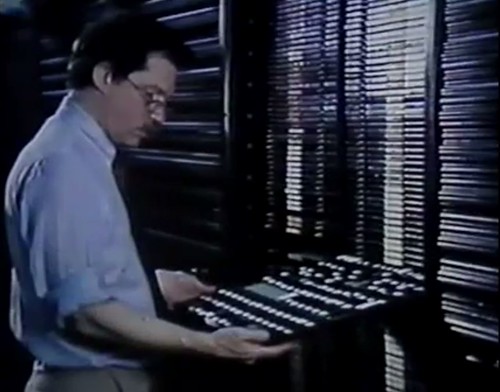
Now THAT'S a handsome coin cabinet!
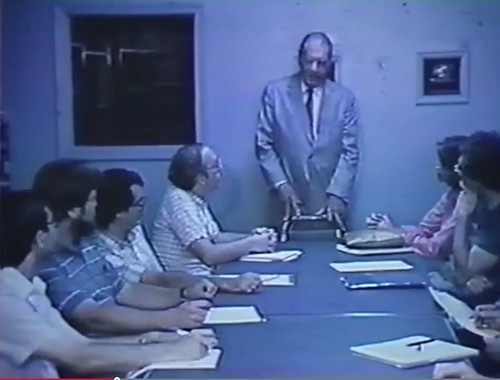
He looks familiar, but gosh, he'd be over 100 by now...
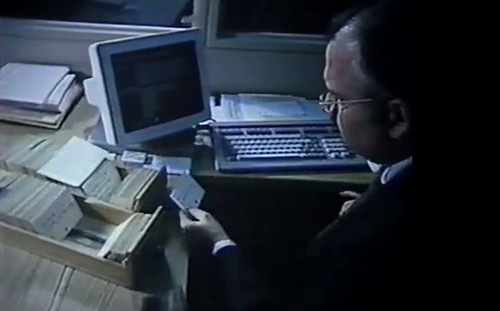
Library catalogs didn't appear on the Internet by magic...
To view the complete video, see:
A TRIP DOWN MEMORY LANE
(www.anspocketchange.org/a-trip-down-memory-lane/)
THE BOOK BAZARRE
LEON LEDERMAN 1988 NOBEL PRIZE MEDAL SOLD
The eastern Idaho resident who wasn’t sure anyone would even bid on his 1988 Nobel Prize medal has seen his prize sell for $765,000.
Driggs resident Leon Lederman and his wife put the medal up for auction after being contacted by a Los Angeles-based company that sells rare prizes and trophies. The minimum bid was $325,000. When the auction ended Thursday night, the winning bid was for $633,335. NBC reports a buyer’s premium will push the final price even higher.
“That put the transaction at No. 4 on the list of 10 Nobel Prize sales over the past 30 years, said Sam Heller, a spokesman for Nate D. Sanders Auctions. The reserve price had been set at $325,000, and six bids were received during a back-and-forth session that went almost two hours into overtime.” – NBC News
Lederman is a renowned physicist. He moved to eastern Idaho full time after retiring from a lab near Chicago. His wife, Ellen, told KBSX this week the couple opted sell the medal to pay for her husband’s future medical care. Leon Lederman is 92 and has dementia.
To read the complete article, see:
Eastern Idaho
Scientist Sells His 1988 Nobel Prize Medal Sell For $765,000
(http://boisestatepublicradio.org/post/eastern-idaho-scientist-sells-his-1988-nobel-prize-medal-sell-765000)
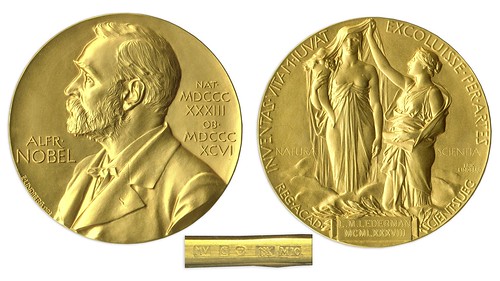
The 1988 Nobel Prize in Physics, awarded to particle physicist Leon Lederman for his discovery of the muon neutrino, a particle 200 times the size of an electron. Lederman, along with colleagues Melvin Schwartz and Jack Steinberger, found the muon neutrino in 1962 while using a high energy particle accelerator. They discovered that in some cases a muon (rather than an electron) was produced, illuminating the existence of a new atomic particle.
Lederman was also instrumental in the discovery of the bottom quark in 1977, and was the champion of the Superconducting Super Collider. His popular 1993 book ''The God Particle: If the Universe is The Answer, What is The Question'' was released to critical acclaim.
This Nobel Prize is made of 18kt gold, plated in 24k gold, as were all Nobel Prize medals awarded after 1980. Medal features the relief portrait of Alfred Nobel to front, with his name and the years of his birth and death. Verso features a relief of the Goddess Isis, whose veil is held up by a woman who represents the genius of science. Encircling the medal are the words ''Inventas vitam juvat excoluisse per artes'', translating to ''And they who bettered life on earth by their newly found mastery''. Lederman's name and 1988 in Roman numerals are engraved on a plaque below the relief of the two women, with ''Reg. Acad. Scient. Suec.'' also written, an abbreviation for The Royal Swedish Academy of Sciences. Etched upon the medal is the name of Erik Lindberg, designer of the Nobel medal.
Housed in the original red leather case with Leon Lederman's name gilt stamped. Medal weighs 173 grams or just over 6 oz. and measures 2.5'' in diameter, consistent with the original Nobel Prize awarded in 1988. Case measures 5.5'' x 5.5'' x 1''. Presented in near fine condition, and with an LOA from Leon Lederman.
To read the complete lot description, see:
Lot #1: Nobel Prize Awarded to Physicist Leon Lederman in 1988
(http://natedsanders.com/LotDetail.aspx?inventoryid=36383)
BUYER’S GUIDE TO THE WORLD’S TOP TROPHIES
They may be the trophies that every scientist, actor or athlete dreams of winning, but sometimes even the world’s top awards are just clutter. That at least is the message from the retired experimental physicist Leon Lederman, who is flogging his Nobel prize medal.
In a high-brow equivalent of cash in the attic, the 92-year-old says he is selling the medal because it is just taking up space in his log cabin. Lederman used his original prize money to buy his holiday home and now wants to get rid of the 1988 trophy. “The prize has been sitting on a shelf somewhere for the last 20 years,” he says. “It seems like a logical thing to do.”
But Lederman is not the first Nobel winner to clear out his cabinet. Last year, James Watson, who helped to discover the double-helix structure of DNA, put his own medal up for auction, only for the new owner, billionaire Alisher Usmanov, to return it to the biologist – despite shelling out £2.6m.
In fact, just about every one of the world’s most coveted awards has found its way on to the market at some point. Here’s a buyer’s guide ...
Grammys
For guitarist Dave Burgess, his Grammy was a much-needed nest egg when a family member became ill. He won the top music award for his
jukebox classic Tequila, recorded in 1958 with other session musicians. But last month the 80-year-old musician decided to sell it to pay
for medical bills, putting it up for auction with a $30,000 reserve price, despite objections from the National Academy of Recording Arts
and Sciences, which hands out the awards.
Olympic medals
While winning an Olympic medal may take blood, tears and years of training, buying one at auction won’t make you break out into a sweat.
Athletes sell them because of financial hardship (Cuban athletes are apparently often quick to sell theirs), or for medical bills (ice
hockey player Mark Wells sold his gold medal after a rare genetic condition affected his spinal cord). Some athletes cash-in on their
hardware to help good causes. Heavyweight boxer Wladimir Klitschko, who won a gold medal in 1996, sold his for $1m to raise money for a
charitable foundation he set up for Ukrainian children.
To read the complete article, see:
How much
for your Nobel prize? A buyer’s guide to the world’s top trophies
(www.theguardian.com/science/shortcuts/2015/may/27/nobel-prize-buyers-guide-to-worlds-top-trophies-leon-lederman)
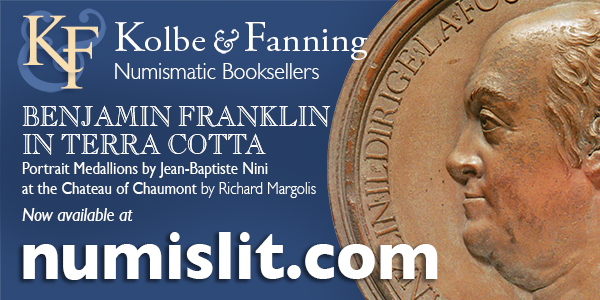
1876 OTTOMAN-ERA WATERMARKED BANKNOTE
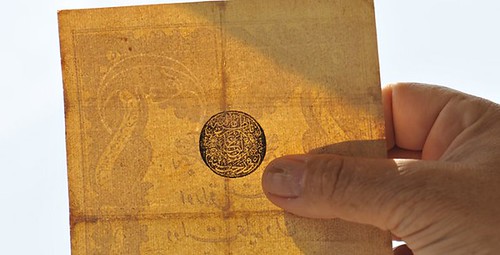
Mehmet Tezcakin, a Turkish expert on banknotes and coins, found an Ottoman-era 50-kurus (piaster) banknote in a lot sent by a collector living in Germany for valuation.
An adviser to an international London-based auction company Spink, Tezcakin said the banknote was dated 1876 with a picture as a watermark.
“I cannot tell the excitement I felt at that moment as all the numismatists in the world are after this banknote,” said Tezcakin.
“That a banknote with a picture watermark was printed has been known for over a hundred years, but it had never before been seen,” said Tezcakin. Few of such watermarked banknotes with pictures were minted.
He said when the banknote was held up to the light, a man is seen, whose eyebrows and nose resemble Ottoman Sultan Abdulhamid II inside a crescent on the banknote.
“During the Ottoman era, no picture could be found on banknotes for religious reasons,” he added.
Tezcakin said he made this historic find public with the permission of the collector who asked not to be named.
To read the complete article, see:
Turkish expert finds Ottoman-era banknote
(http://news.videonews.us/turkish-expert-finds-ottoman-era-banknote-2920868.html)
THE BOOK BAZARRE
1831 RUSSIAN PLATINUM 6 RUBLE OVERDATE
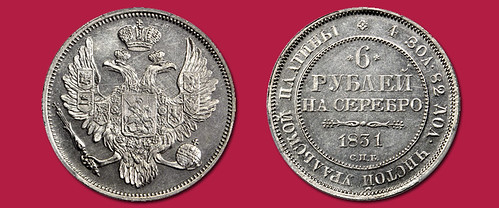
Russia is the only country to strike platinum coins for circulation. The word platinum is a derivative of the Spanish platina, which means “little silver” and at first glance the two are visually similar. This similarity would be a factor in its eventual failure as a circulation coinage in Russia.
The discovery of platinum in the Urals of Western Siberia resulted in the production of three new Russian decimal coinage denominations. By the imperial decree of April 24, 1828, platinum coinage was initiated for circulation; however, the initial minting was only of the 3 Ruble denomination. The decree authorizing the production of 6 and 12 Rubles came later. The planchet size for this issue was consistent in diameter to that of the silver Poltina (1/2 Ruble). The minting of platinum coinage in 19th century Russia was very limited and for a period of less than two decades. The new coinage denominations were not well received by the public, as they their pale white metal was unfamiliar in circulation.
In 1845, an imperial decree ordered the minting of platinum coinage to cease. Simultaneously, the existing pieces were ordered to be recalled within a six month period. In this way much of the original mintages were redeemed and destroyed, accounting for their rarity today. The six-month period was too short for all the platinum issues to be redeemed and destroyed, and it is largely responsible for the examples known today.
The obverse design for this platinum 6 Ruble features a large motif of the Imperial Coat of Arms: the Imperial double headed eagle, each head crowned with a third crown and banner above. The left claw holds a scepter, representing monarchial power, and the globus cruciger in the right claw demonstrates the religious authority of the emperor. The Order of Saint Andrew, the highest honorary order in Imperial Russia, appears around the arms of Moscow showing Saint George mounted and defeating the dragon.
The central inscription states: “6 Rubles per Silver” this wording was used to link this platinum series to the familiar silver ruble. Just below this inscription appear the overdate of 1831/0 and the St. Petersburg mintmark. This is the only example of an overdate certified by either grading service. The bottom of the "0" is clearly evident beneath the "1", with the top of the"1" extending well above the tops of the other digits in the date. Well struck, especially given the hardness of the metal, the details in St. George as he slays the dragon are simply phenomenal. Prooflike fields accentuate the frosty white devices and add to the appeal of this fabulous Russian rarity.
Look for this and other world numismatic rarities in our upcoming August ANA World’s Fair of Money Auction.
To read the complete article, see:
Mint State Imperial Russian Platinum 6 Ruble Overdate (www.stacksbowers.com/NewsMedia/Blogs/TabId/780/ArtMID/
2678/ArticleID/65167/Mint-State-Imperial-Russian-Platinum-6-Ruble-Overdate.aspx)
GREEK'S DESIGN CHOSEN FOR EUROPEAN UNION'S FLAG COIN
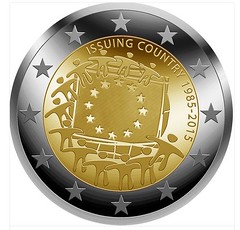 A new two-euro coin to commemorate the 30th anniversary of the European Union's flag will show a design by a Greek engraver. But the
coin may last longer than Greece's membership in the euro zone.
A new two-euro coin to commemorate the 30th anniversary of the European Union's flag will show a design by a Greek engraver. But the
coin may last longer than Greece's membership in the euro zone.
Greek central bank engraver George Stamatopoulos on Thursday won a competition to design the logo of a commemorative two-euro coin. His proposal had been preselected by a jury alongside designs from Spain, Slovenia, Italy and Cyprus.
Marking the 30th anniversary of the EU flag, Stamatopoulos' entry depicts 12 people forming a human chain around that flag with the 12 gold stars on a blue background.
The design was chosen by 30 percent of 100,000 voters in an online competition by the European Commission.
Its Vice President Valdis Dombrovskis said the coin celebrated a key moment of the adoption of the flag as the EU's official emblem.
About 75 million of the two-euro coins will circulate in eurozone nations, starting in July. But as Greece's new hard-left government keeps struggling to get another shot in the arm from its creditors, fears are growing the country may eventually drop out of the euro area.
The new two-euro coin would then become commemorative in one more way, economists quipped.
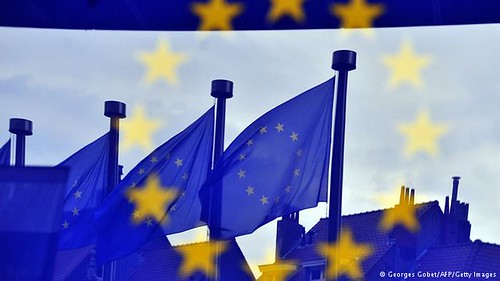
To read the complete article, see:
Greek engraver wins euro coin design competition
(www.dw.de/greek-engraver-wins-euro-coin-design-competition/a-18481782)
MONNAIE DE PARIS FIGHTS COLORIZED FRENCH EURO COINS
Colorized U.S. coins have been sold in the American coin collecting hobby for years.
Some are mass produced, such as gold-plated state quarters.
Some are hand-colored artwork on classic designs such as the Buffalo nickel.
When these pieces are found in circulation, they sometimes cause puzzlement to the finders. Some assume they are products of the U.S. Mint. They are not, though the underlying coins are. Some assume they are illegal. They are not.
Unless the colorization process is part of an attempt to defraud the people who originally buy these sorts of coins, there is nothing illegal about it – in the United States.
The same cannot be said of other countries.
This sort of thing is illegal in France, as a letter sent out by the chairman and CEO of Monnaie de Paris reminds dealers and other sellers.
It begins:
“Dear Sir or Madam, I have noted that many coins issued by Monnaie de Paris have been altered by colouring or by gilding and were being sold on to the public in this altered form.
“These practices, which affect, in particular, the 2-euro commemorative coins issued by Monnaie de Paris, together with some collectors’ items, are illegal. They contravene the intellectual property rights of Monnaie de Paris, and also various statutory and regulatory provisions, of French and Community law, governing the status and the appearance of euro currency coins.
“It is essential that a stop is put to these practices."
The letter, which only a lawyer can love, runs nearly nine pages and spells out the law and the penalties for breaking it.
You will not get sent to Devil’s Island, but the penalties are severe enough.
There is some huffing and puffing in the text of the letter. After threatening these terrible penalties, comes the statement: “The criminal offences mentioned above would therefore be intended to apply if it was argued or suggested that coloured or gilded coins offered for sale are still intended for circulation or likely to be put into circulation.”
Since the sellers of these coins that I am used to seeing in the United States do not say or imply that the coins are to be used in circulation, you would think the legal treatment of colorized euro coins would be the same in France as the United States.
Hence the need for the long letter.
It spells out that colorizing infringes on the mint’s intellectual property rights, violates the French consumer code and is even unfair competition.
Is this a tempest in a teapot?
To read the complete article, see:
Don’t you dare colorize euros
(www.numismaticnews.net/buzz/dont-you-dare-colorize-euros)
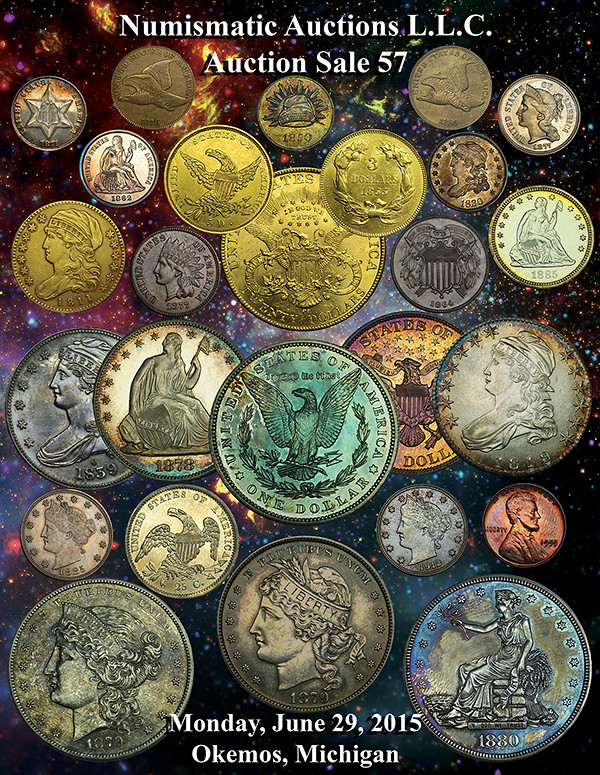
KIDS EXCAVATE OLD COINS FROM A CLASSROOM CLOSET
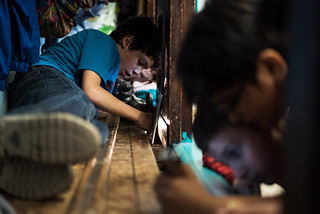 Bobby Scotto, a fourth grader at the Children’s Workshop School on 12th Street in the East Village, wants to be an archaeologist when he
grows up, and he is already off to a good start. In the past few months he has excavated dozens of old coins, a toy watch and other
artifacts, all from an unlikely dig site: his classroom’s closet.
Bobby Scotto, a fourth grader at the Children’s Workshop School on 12th Street in the East Village, wants to be an archaeologist when he
grows up, and he is already off to a good start. In the past few months he has excavated dozens of old coins, a toy watch and other
artifacts, all from an unlikely dig site: his classroom’s closet.
Bobby, an earnest 10-year-old with a mop of dark hair and saucerlike brown eyes, was bitten by the archaeology bug four or five months ago, when his class read a book about a migrant farmworker who found old coins in a field. Bobby decided he wanted to collect old coins of his own, and he had noticed a small gap between the floorboards in the closet. So he reached into that gap as far as he could and, voilà, out came a bunch of wheat pennies (minted from 1909 to 1958), a buffalo nickel and other treasures.
Bobby and his best friend in the class, Lizardo Lozada, soon began reaching farther underneath the floorboards with the help of simple tools — pencils, scissors, untwisted coat hangers. “At first the other kids were like, ‘What are you doing?’ ” Bobby said one recent afternoon while demonstrating his technique. “But then they saw we were finding old, cool stuff, so they started doing it and finding cool stuff, too.”
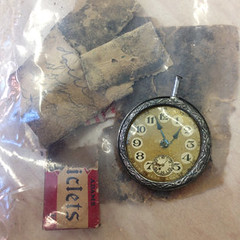 And so began an improbable exercise in hands-on archaeology that soon attracted all 21 students in
the class. “There’s something about the degree of difficulty that’s just perfect,” said the class’s teacher, Miriam Sicherman, 43, who has
been teaching at the school for 15 years. “You can’t just reach in and grab something, but it is possible to get something. There’s just
enough gratification.”
And so began an improbable exercise in hands-on archaeology that soon attracted all 21 students in
the class. “There’s something about the degree of difficulty that’s just perfect,” said the class’s teacher, Miriam Sicherman, 43, who has
been teaching at the school for 15 years. “You can’t just reach in and grab something, but it is possible to get something. There’s just
enough gratification.”
Along the way, the students have also become adept at research (when they find something, they try to learn more about it on the web); cataloging (each object is logged on a sheet that Ms. Sicherman helped the students design); preservation (the artifacts are kept in plastic bags); and documentation (Ms. Sicherman posts photos of the artifacts on an Instagram account). And as their excavations began to yield diminishing returns, they sought out new dig sites, receiving permission to explore closets in adjacent classrooms.
Ms. Sicherman has arranged for a professional archaeologist to visit the class, and there are plans for the artifacts to be displayed in some sort of exhibition, perhaps in the school’s library. The principal, Maria Velez-Clarke, said she had considered enlisting the custodial staff to remove some of the closet floorboards, which would provide easier access to whatever is still beneath them.
Not everyone likes that idea. “That might be a little too easy,” Bobby said. “We’d find something every five seconds.” Other students expressed similar reservations. The thrill of the hunt is apparently a big part of the project’s appeal.
That is not to say that Bobby is opposed to taking the hunt to the next level. He has asked his uncle, Robert Silver, for a metal detector. “But I told him it’s very expensive,” Mr. Silver said, “so he’ll have to wait until Christmas.”
Dennis adds:
Kudos to their teacher, who’s encouraging the kids to explore and to connect the treasures they find (including coins) to their school lessons!
I also sent this to Dave Bowers and Whitman associate editor John McCurdy. We’re putting the finishing touches on a new QDB book—Lost and Found Coin Hoards and Treasures: Illustrated Stories of the Greatest American Troves and Their Discoveries —which will be out later this year.
To read the complete article, see:
Young
Treasure Hunters Dig Up History Lessons in a Classroom’s Closet
(www.nytimes.com/2015/05/26/nyregion/young-treasure-hunters-dig-up-history-lessons-in-a-classrooms-closet.html)
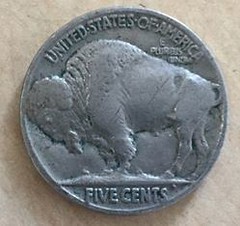
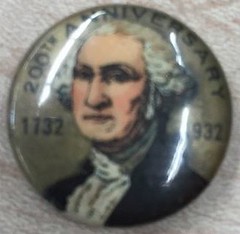
To read the Instagram feed, see:
closetarchaeology (https://instagram.com/closetarchaeology/)

